Most innovative companies for 07/02/2024 (new inventions)
Exciting new inventions from Samsung Electronics Co., Ltd., Apple Inc., Qualcomm Incorporated And Toyota Jidosha Kabushiki Kaisha
This is a weekly article summarizing a handful of inventions from the most innovative companies in the world. The summaries are created by an A. I. and proof-read by a human before publication. Attempts are made to ensure accuracy of the descriptions, but it is very much a work in progress. Each invention description is preceeded by a poem about the invention that is written by the A. I. I have found the limerick is actually quite good at explaining the invention in simple terms. Enjoy!
Samsung Electronics Co., Ltd.
"Samsung Patents Innovative Cooking Apparatus Controlling System"
What is this invention?
Cooking apparatus, cooking apparatus controlling system, and method of controlling cooking apparatus
In a kitchen so high-tech and grand,
A cooking apparatus control plan was planned,
With user commands at hand,
One for each apparatus stand,
Communicators joining, a futuristic band.
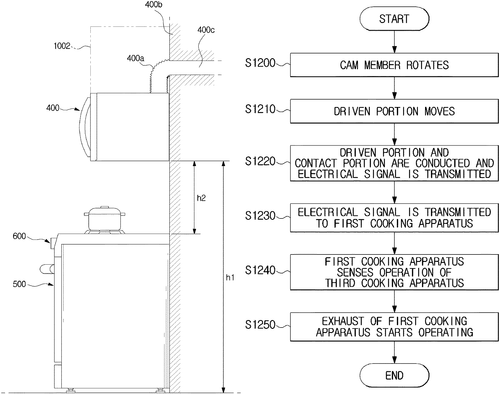
Samsung Electronics Co., Ltd. has recently patented a new cooking apparatus controlling system that allows for seamless communication between two separate cooking devices. The system includes a user interface on the first cooking apparatus that can transmit user commands to a second cooking apparatus, which will then operate accordingly. This innovative technology could potentially revolutionize the way we cook by allowing for more efficient and coordinated meal preparation. Competitors in the smart kitchen appliance market, such as Whirlpool and LG, may need to step up their game if this patent becomes a reality. Imagine being able to start preheating your oven from your stovetop or seamlessly transferring cooking instructions from your grill to your slow cooker. While this patent offers an exciting glimpse into the future of cooking technology, the practicality and feasibility of such a system being brought to market remain to be seen. Will consumers embrace this level of interconnectedness in their kitchen appliances, or will they prefer to stick with traditional methods? Share your thoughts in the comments below.
Abstract
A cooking apparatus, a cooking apparatus controlling system, and a method of controlling a cooking apparatus are provided. The cooking apparatus controlling system includes a first cooking apparatus having a user interface configured to receive a user command from a user and a second cooking apparatus separated from the first cooking apparatus and configured to receive the user command input to the first cooking apparatus and operate according to the user command. The user interface receives one or more of a user command related to the first cooking apparatus and a user command related to the second cooking apparatus. The first cooking apparatus includes a first communicator. The second cooking apparatus includes a second communicator configured to communicate with the first communicator. A cooking apparatus, a cooking apparatus controlling system, and a method of controlling a cooking apparatus are provided. The cooking apparatus controlling system includes a first cooking apparatus having a user interface configured to receive a user command from a user and a second cooking apparatus separated from the first cooking apparatus and configured to receive the user command input to the first cooking apparatus and operate according to the user command. The user interface receives one or more of a user command related to the first cooking apparatus and a user command related to the second cooking apparatus. The first cooking apparatus includes a first communicator. The second cooking apparatus includes a second communicator configured to communicate with the first communicator.
US Patent 12022854
Samsung Electronics Co., Ltd.
"Samsung Patent Revolutionizes Actuator Technology with Sequential Power Transmitters"
What is this invention?
Actuator and motion assistance apparatus including the same
In the realm of technology's glow,
An actuator's grand show!
Power transmitters in line,
Elastic element, so fine,
Coaxial rotation, watch it go!
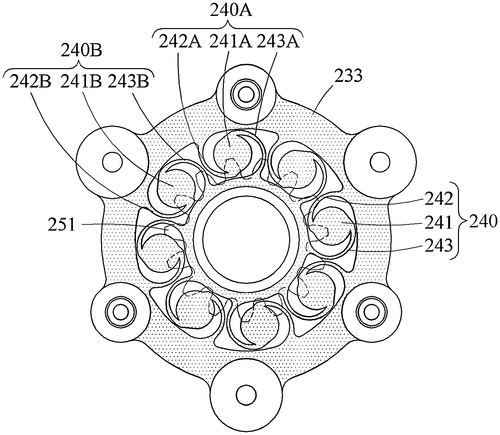
In a recent patent filed by Samsung Electronics Co., Ltd., the company describes an innovative actuator that utilizes multiple power transmitters and an elastic element to enable coaxial rotation motion. This new technology can potentially have a variety of applications, from improving the functionality of consumer electronics to enhancing the performance of industrial machinery. While the details of how this actuator will be integrated into Samsung's products remain to be seen, it's clear that this development could bring about significant advancements in the realm of tactile feedback, haptic technology, and robotics. Competitors in the tech industry, such as Apple and Google, are already exploring similar technologies in their devices, but Samsung's approach appears to offer a unique spin on the concept. One can imagine this actuator being used in future smart devices to provide more immersive gaming experiences, more realistic tactile feedback in virtual environments, or even in medical devices for precise and controlled movement. The question that comes to mind is: How do you think this new actuator technology from Samsung could revolutionize the way we interact with technology in our daily lives? Let us know your thoughts in the comments below.
Abstract
An actuator includes a plurality of power transmitters configured to transmit power sequentially, and an elastic element configured to connect a first power transmitter and a second power transmitter that are adjacent to each other and perform a coaxial rotation motion, among the plurality of power transmitters. An actuator includes a plurality of power transmitters configured to transmit power sequentially, and an elastic element configured to connect a first power transmitter and a second power transmitter that are adjacent to each other and perform a coaxial rotation motion, among the plurality of power transmitters.
US Patent 12023264
Samsung Electronics Co., Ltd.
"Samsung's New Washing Machine Design Eliminates Front Lines for a Sleeker Look"
What is this invention?
Washing machine
In a cabinet with frames all around,
A washer so sleek and profound,
Front frame and cover complete,
No lines to mar the neat,
Enhancing the exterior's astound.
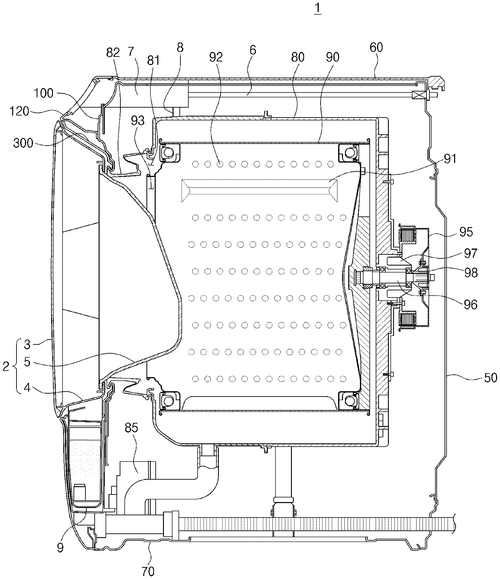
Samsung Electronics Co., Ltd. has patented a new design for a washing machine that aims to enhance the exterior appearance of the appliance. The innovative feature of this washing machine is the seamless front cover that eliminates any visible lines, giving the machine a sleek and modern look. In a market flooded with various washing machine models from competitors like LG and Whirlpool, Samsung's design could stand out for its seamless and minimalist aesthetic. Imagine having a washing machine that not only efficiently cleans your clothes but also adds a touch of elegance to your laundry room. Will consumers prioritize style and design when choosing a new washing machine, or will practicality and functionality still reign supreme? Let us know in the comments below!
Abstract
Provided is a washing machine including: a cabinet including a plurality of side frames, a back frame, a top frame and a bottom frame; a front frame that is disposed in front of the cabinet and includes an internal laundry port through which laundry is put into a rotating tub, and a front cover that is disposed in front of the front frame, extends from the top frame to the bottom frame, includes an external laundry port corresponding to the internal laundry port and is integrally formed. Thus, no line is formed in a front side of the washing machine so that the exterior of the washing machine can be enhanced. Provided is a washing machine including: a cabinet including a plurality of side frames, a back frame, a top frame and a bottom frame; a front frame that is disposed in front of the cabinet and includes an internal laundry port through which laundry is put into a rotating tub, and a front cover that is disposed in front of the front frame, extends from the top frame to the bottom frame, includes an external laundry port corresponding to the internal laundry port and is integrally formed. Thus, no line is formed in a front side of the washing machine so that the exterior of the washing machine can be enhanced.
US Patent 12024810
Samsung Electronics Co., Ltd.
Revolutionizing Measurement: Samsung's 3D Device Redefines Object Scanning
What is this invention?
Heating cooker including three dimensional measuring device
In a world where precision is key,
A 3D device comes to be,
With shafts that rotate and capturers so neat,
It captures the shape, all in light and heat,
A technological marvel, you must see!
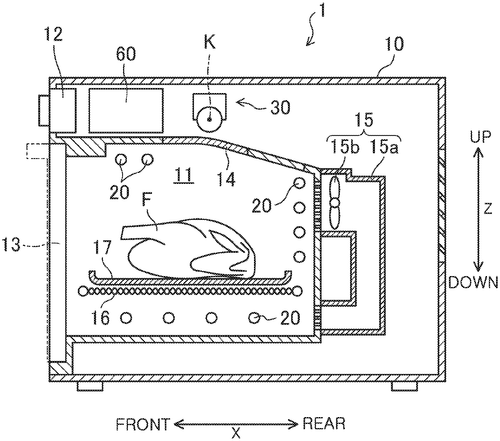
Samsung Electronics Co., Ltd. has recently patented a cutting-edge 3D measuring device that has the potential to revolutionize the way we capture objects in three dimensions. The device boasts a rotational supporting shaft, a beam irradiator, a capturer, and a processor that work together seamlessly to obtain a detailed 3D shape of an object as the device is rotated. Competitor's products in the market may soon have to step up their game as Samsung's innovative device promises precise and accurate measurements with its advanced technology. Imagine the possibilities this device could bring to industries such as architecture, healthcare, and design. From creating detailed models for construction projects to capturing accurate body measurements for tailored clothing, the applications of this device could be endless. While the patent sounds promising, the real question remains: Will Samsung bring this 3D measuring device to the market for consumers and businesses to benefit from its groundbreaking capabilities? What do you think about the potential impact of such a device on various industries? Share your thoughts in the comments below.
Abstract
A three dimensional (3D) measuring device. The 3D measuring device includes a rotational supporting shaft, a supporting frame configured to support the supporting shaft, a beam irradiator arranged at the supporting shaft for irradiating beam of light onto an object, a capturer arranged at the supporting shaft to be at a distance from the beam irradiator and configured to capture the beam projected on the object, and at least one processor configured to control rotation of the supporting shaft and obtain a 3D shape of the object based on image information obtained by the capturer as the supporting shaft is rotated. A three dimensional (3D) measuring device. The 3D measuring device includes a rotational supporting shaft, a supporting frame configured to support the supporting shaft, a beam irradiator arranged at the supporting shaft for irradiating beam of light onto an object, a capturer arranged at the supporting shaft to be at a distance from the beam irradiator and configured to capture the beam projected on the object, and at least one processor configured to control rotation of the supporting shaft and obtain a 3D shape of the object based on image information obtained by the capturer as the supporting shaft is rotated.
US Patent 12025431
Samsung Electronics Co., Ltd.
"Innovative Semiconductor Inspection System by Samsung Electronics Co., Ltd. Utilizes Water Tank Technology for Superior Results"
What is this invention?
Apparatus and method for inspecting semiconductor
In a semiconductor world so vast,
An apparatus is unsurpassed,
With signal generators and probe,
Removing foreign matter, no probe.
Inspecting with a power so vast.
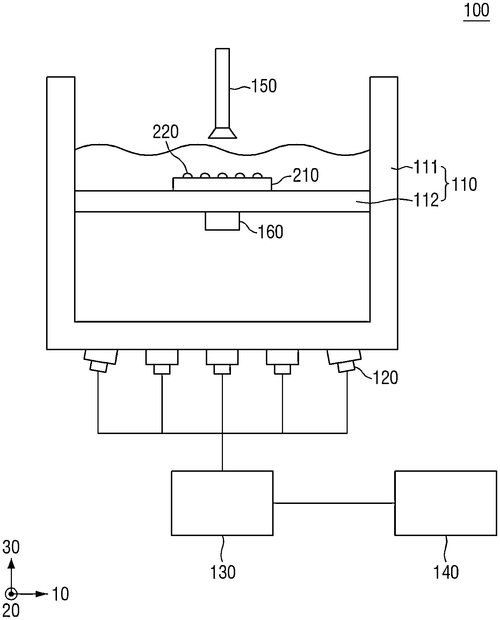
In a recent patent application by Samsung Electronics Co., Ltd., a novel apparatus and method for inspecting semiconductors has been unveiled. This innovative system includes a water tank filled with liquid, equipped with signal generators that emit frequency signals towards the inspection object. By placing a probe above the object and using a receiver, foreign matter on the surface can be effectively removed. While Samsung's new invention showcases potential advancements in semiconductor inspection technology, it remains to be seen if this concept will be transformed into a market-ready product. Competitors in the industry, such as Intel and NVIDIA, already have established methods for semiconductor inspection, making it essential for Samsung to demonstrate the practicality and efficiency of their proposed system. If brought to fruition, this invention could revolutionize the semiconductor industry by enhancing the accuracy and speed of inspections. Imagine the possibility of faster production cycles and improved quality control in semiconductor manufacturing plants worldwide. What do you think? Could Samsung's proposed apparatus become the new standard for semiconductor inspection, or will it encounter challenges in implementation? Share your thoughts in the comments below.
Abstract
An apparatus and a method for inspecting a semiconductor includes a water tank which includes a housing, an interior of which is filled with a liquid, and a support block which provides a settling surface for an inspection object inside the housing. A plurality of signal generators are installed on a bottom surface of the housing, and output a frequency signal in a direction in which the inspection object is located. A power supply operates the signal generators. A probe is placed above the inspection object, and a receiver which operates with the probe and is attached to a bottom surface of the support block. Foreign matter remaining on the inspection object are removed, using a plurality of frequency signals which are output by the plurality of signal generating units. An apparatus and a method for inspecting a semiconductor includes a water tank which includes a housing, an interior of which is filled with a liquid, and a support block which provides a settling surface for an inspection object inside the housing. A plurality of signal generators are installed on a bottom surface of the housing, and output a frequency signal in a direction in which the inspection object is located. A power supply operates the signal generators. A probe is placed above the inspection object, and a receiver which operates with the probe and is attached to a bottom surface of the support block. Foreign matter remaining on the inspection object are removed, using a plurality of frequency signals which are output by the plurality of signal generating units.
US Patent 12025652
Apple Inc.
"Apple Patents Next-Gen Optical Sensing Technology with Enhanced Light Restriction Designs"
What is this invention?
Light restriction designs in optical sensing applications having shared windows
In a realm of optical sensing so bright,
An electronic device takes flight,
With shared windows in view,
And designs that imbue,
No crosstalk, just angles just right.
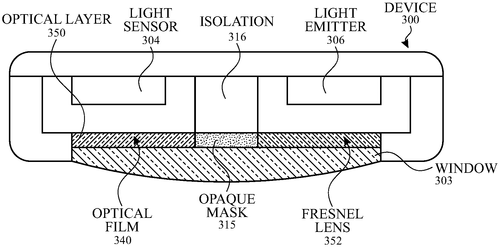
Apple Inc. has filed a patent for an electronic device with advanced optical sensing capabilities, featuring innovative light restriction designs to enhance performance. This technology aims to minimize crosstalk between optical components by employing various optical layers, films, lenses, and window systems. The patent describes a system that uses accepting and blocking sections to control the angles at which light is allowed to enter the device for sensing purposes. By selectively permitting light within specified viewing angles and blocking out stray light, this design could potentially improve the accuracy and efficiency of optical sensing in electronic devices. While this development could lead to enhanced optical capabilities in future Apple products, it will be interesting to see how it compares to similar technologies already available from competitors such as Samsung and Google. How do you think this new optical sensing technology from Apple will impact the future of smartphone features and functionalities? Share your thoughts in the comments below.
Abstract
This relates to an electronic device configured for optical sensing having shared windows and including light restriction designs. The light restriction designs can include one or more of optical layers, optical films, lenses, and window systems configured to reduce or eliminate crosstalk between optical components. A plurality of accepting sections and a plurality of blocking sections can be employed to selectively allow light having an angle of incidence within one or more acceptance viewing angles and block light with angles of incidence outside of the acceptance viewing angles. In some examples, the light restriction designs can include variations in optical and structural properties can allow the light restriction designs to have spatially varying acceptance angles. Variations in structural properties can include, but are not limited to, differences in widths, heights, and/or tilts of the accepting sections and/or blocking sections. This relates to an electronic device configured for optical sensing having shared windows and including light restriction designs. The light restriction designs can include one or more of optical layers, optical films, lenses, and window systems configured to reduce or eliminate crosstalk between optical components. A plurality of accepting sections and a plurality of blocking sections can be employed to selectively allow light having an angle of incidence within one or more acceptance viewing angles and block light with angles of incidence outside of the acceptance viewing angles. In some examples, the light restriction designs can include variations in optical and structural properties can allow the light restriction designs to have spatially varying acceptance angles. Variations in structural properties can include, but are not limited to, differences in widths, heights, and/or tilts of the accepting sections and/or blocking sections.
US Patent 12023153
Apple Inc.
"Apple Inc. Patents Revolutionary User Interface for Workout Management and Output"
What is this invention?
User interfaces for physical activity information
In the realm of fitness, we find neat
User interfaces, oh so sweet
For managing, modifying, outputting galore
Workout content at our core
Innovation meets sweat, a perfect feat

Apple Inc. has recently filed a patent related to user interfaces for managing, modifying, and outputting workout content. This technology could potentially revolutionize how users interact with their fitness routines. While there are already numerous fitness apps and devices on the market, Apple's patent hints at a more streamlined and intuitive user experience. Imagine being able to easily customize your workout content, track your progress, and share achievements with friends all from one simple interface. With the rise of smartwatches and fitness trackers, incorporating this technology could give Apple a leg up on competitors in the fitness tech space, such as Fitbit and Garmin. The potential uses for this innovation are vast. From professional athletes looking to fine-tune their training programs to casual gym-goers wanting to spice up their routines, Apple's user interface could cater to a wide range of fitness enthusiasts. But the question remains: Will this patent actually be developed into a tangible product for consumers to use? How would you like to see this technology integrated into Apple's current lineup of products? Share your thoughts in the comments below.
Abstract
The present disclosure generally relates to user interfaces for managing, modifying, and/or outputting workout content. The present disclosure generally relates to user interfaces for managing, modifying, and/or outputting workout content.
US Patent 12023567
Apple Inc.
"Apple's Innovative Band Design: Patent Reveals Multi-Structure Assembly for Electronic Devices"
What is this invention?
Multi-tensile assembly for a band used with electronic devices
In a band of electronic delight,
Structures with tensile strengths unite,
Low-tensile elongates with ease,
High-tensile guards with expertise,
Together, they form a band that's just right.
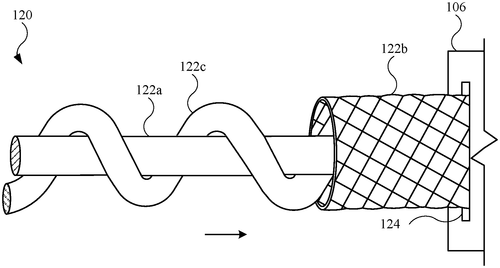
Apple Inc. has recently patented an innovative assembly that may revolutionize the design of bands for electronic devices. This new technology incorporates multiple structures with varying tensile strengths, allowing for a dynamic and adaptive user experience. Imagine a smartwatch band that can stretch and lengthen to fit comfortably on your wrist, thanks to a low-tensile structure that elongates under initial tension. As you move and use your device, the band adjusts to your movements, providing a customized and secure fit. Yet, when additional tension is applied, the high-tensile strength structure kicks in to prevent overstretching and potential damage to the band. Competitors in the wearable technology market should take note of this potential game-changer from Apple. With its focus on user comfort and durability, this assembly could set a new standard for bands across various electronic devices. How do you envision this technology being applied beyond smartwatches? Could it be integrated into other wearable tech, such as fitness trackers or headphones, to enhance user experience even further? Share your thoughts in the comments below.
Abstract
An assembly with multiple structures, each having different tensile strengths, is integrated into a band used with various electronic devices. The assembly may include a low-tensile structure designed to elongate under an initial tension, thus allowing the band to stretch and lengthen. However, additional tension applied to the band is transferred to other structures of the assembly. Further, when the applied tension causes the structure with the highest tensile strength in the assembly to straighten (or substantially straighten), the high-tensile strength structure prevents the band from further elongation. The low-tensile strength structure allows the band to conform to a user, while the high-tensile strength structure protects the low-tensile strength structure from damage or unwanted deformation. An assembly with multiple structures, each having different tensile strengths, is integrated into a band used with various electronic devices. The assembly may include a low-tensile structure designed to elongate under an initial tension, thus allowing the band to stretch and lengthen. However, additional tension applied to the band is transferred to other structures of the assembly. Further, when the applied tension causes the structure with the highest tensile strength in the assembly to straighten (or substantially straighten), the high-tensile strength structure prevents the band from further elongation. The low-tensile strength structure allows the band to conform to a user, while the high-tensile strength structure protects the low-tensile strength structure from damage or unwanted deformation.
US Patent 12024820
Apple Inc.
"Apple Inc. Patents Groundbreaking Data Transfer System for Devices with Reduced Power Consumption"
What is this invention?
Method for performing system and power management over a serial data communication interface
In a realm of tech innovation grand,
Data transfer between devices planned.
Pulses counted, encoded with care,
Bidirectional line, power usage spare.
Efficient methods, a high-tech command.
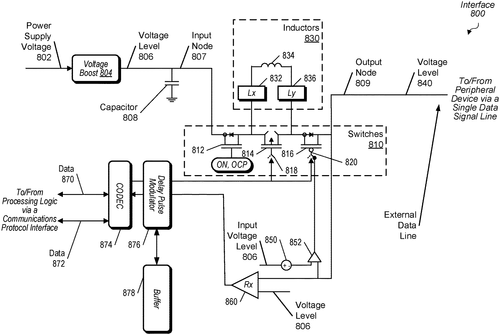
Apple Inc. has recently filed a patent for a system and method that aims to efficiently transfer data between devices. This innovative approach involves encoding parallel data as pulses and conveying them to a peripheral device, which then decodes the pulses to retrieve the original data. By utilizing a bidirectional line and a non-zero base voltage level, the devices can communicate effectively while reducing power consumption. This proposed technology has the potential to revolutionize data transfer processes between devices, offering a more energy-efficient solution compared to current methods. With the increasing demand for seamless connectivity and environmentally friendly technologies, Apple's system could have a significant impact on the tech industry. As we eagerly await further developments on this patent, one can't help but wonder: How could this efficient data transfer system enhance the performance of Apple's existing products and potentially challenge competitors in the market? Share your thoughts in the comments below.
Abstract
A system and method for efficiently transferring data between devices. In various embodiments, a host computing device receives parallel data, encodes the parallel data as a count of pulses as serial data, and conveys the serial data to a peripheral device. The peripheral device decodes the received serial data to determine the parallel data, which is sent to processing logic. The devices send the encoded pluses on a bidirectional line, so the pulses are capable of being sent in both directions. The devices send the encoded pulses on the bidirectional line using a non-zero base voltage level. The devices are capable of using a voltage headroom when conveying encoded pulses between one another. Therefore, a full voltage swing between a ground reference voltage level and a power supply voltage level is not used when conveying the encoded pulses, which reduces power consumption. A system and method for efficiently transferring data between devices. In various embodiments, a host computing device receives parallel data, encodes the parallel data as a count of pulses as serial data, and conveys the serial data to a peripheral device. The peripheral device decodes the received serial data to determine the parallel data, which is sent to processing logic. The devices send the encoded pluses on a bidirectional line, so the pulses are capable of being sent in both directions. The devices send the encoded pulses on the bidirectional line using a non-zero base voltage level. The devices are capable of using a voltage headroom when conveying encoded pulses between one another. Therefore, a full voltage swing between a ground reference voltage level and a power supply voltage level is not used when conveying the encoded pulses, which reduces power consumption.
US Patent 12026033
Apple Inc.
"Innovative Patent by Apple: Updating Page Pools with Cached Descriptors"
What is this invention?
Hardware-assisted page pool grow operation
In the realm of cached page pool traits,
Techniques for updating, oh what waits!
A processor's task, a list to be grown,
Memory blocks added, signals are shown,
Page pools evolving, tech navigates.
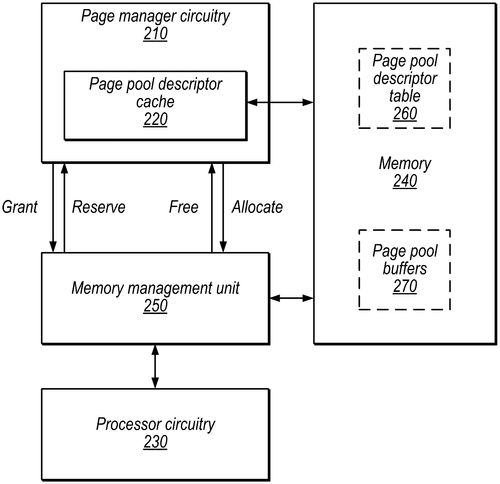
In a recent patent application by Apple Inc., new techniques for updating page pools within memory systems have been revealed. This innovation involves assigning processing work to specific memory pages and utilizing page manager circuitry to handle the caching of page pool descriptor entries. Essentially, this technology allows for the seamless expansion of memory pools by adding additional memory blocks as needed. While this patent may not sound as flashy as the latest iPh. one or MacBo. ok, it showcases Apple's dedication to enhancing the efficiency and performance of their devices. Competitors in the tech industry, such as Samsung and Microsoft, are constantly striving to optimize memory management in their products, making this development a step in the right direction for Apple to stay ahead in the game. The potential uses for this technology could be far-reaching, from improving multitasking capabilities on smartphones to enhancing the speed and responsiveness of laptops and tablets. Imagine a future where your device automatically adjusts its memory allocation based on the tasks at hand, providing a seamless user experience without any lag or delays. However, the big question remains: Will Apple be able to successfully implement this patented technology into their products, or will it remain just another entry in their extensive patent portfolio? How do you think this innovation could impact the future of technology devices? Share your thoughts in the comments below.
Abstract
Techniques are disclosed relating to updating page pools in the context of cached page pool descriptors. In some embodiments, a processor is configured to assign a set of processing work to a first page pool of memory pages. Page manager circuitry may cache page pool descriptor entries in cache circuitry, where a given page pool descriptor entry indicates a set of pages assigned to a page pool. In response to a determination to grow the first page pool, the processor may communicate a grow list to the page manager circuitry, that identifies a set of memory blocks from the memory to be added to the first page pool. The page manager circuitry may then update a cached page pool descriptor entry for the first page pool to indicate the added memory blocks and generate a signal to inform the processor that the cached page pool descriptor entry is updated. Techniques are disclosed relating to updating page pools in the context of cached page pool descriptors. In some embodiments, a processor is configured to assign a set of processing work to a first page pool of memory pages. Page manager circuitry may cache page pool descriptor entries in cache circuitry, where a given page pool descriptor entry indicates a set of pages assigned to a page pool. In response to a determination to grow the first page pool, the processor may communicate a grow list to the page manager circuitry, that identifies a set of memory blocks from the memory to be added to the first page pool. The page manager circuitry may then update a cached page pool descriptor entry for the first page pool to indicate the added memory blocks and generate a signal to inform the processor that the cached page pool descriptor entry is updated.
US Patent 12026098
SAMSUNG ELECTRONICS CO., LTD.
Cutting-Edge Samsung Apparatus Harnesses Dual Pulse Waves to Estimate Bio-Information
What is this invention?
Apparatus and method for estimating bio-information
Innovation in bio-info estimation,
With sensors and processing combination,
Channels measuring waves,
Oscillograms it craves,
Converting delay into bio-information!
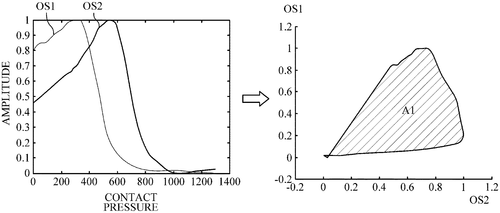
Samsung Electronics has recently patented an intriguing apparatus for estimating bio-information, which utilizes a pulse wave sensor and a processor to analyze multiple channels measuring pulse wave signals of different wavelengths. This innovative device generates oscillograms based on these signals and converts phase delays into actionable data for estimating bio-information. In a market already flooded with wearable health trackers and devices, Samsung's patent hints at a new frontier in biometric monitoring. Imagine a future where individuals can track their health with unparalleled accuracy, thanks to sophisticated sensors and processors working seamlessly together. Will Samsung be able to transform this patented concept into a consumer product that revolutionizes the way we monitor our health? Would you trust a device like this to provide accurate bio-information? Let us know in the comments below.
Abstract
An apparatus for estimating bio-information, the apparatus including a pulse wave sensor and a processor. The pulse wave sensor includes a plurality of channels, each channel of the plurality of channels being configured to measure a first pulse wave signal of a first wavelength and a second pulse wave signal of a second wavelength that is different from the first wavelength. The processor is configured to: for each channel of the plurality of channels, generate a first oscillogram based on the first pulse wave signal, generate a second oscillogram based on the second pulse wave signal, and convert a phase delay between the first oscillogram and the second oscillogram into an area. The processor is further configured to determine a channel among the plurality of channels based on the area of each channel, and estimate bio-information based on the determined channel. An apparatus for estimating bio-information, the apparatus including a pulse wave sensor and a processor. The pulse wave sensor includes a plurality of channels, each channel of the plurality of channels being configured to measure a first pulse wave signal of a first wavelength and a second pulse wave signal of a second wavelength that is different from the first wavelength. The processor is configured to: for each channel of the plurality of channels, generate a first oscillogram based on the first pulse wave signal, generate a second oscillogram based on the second pulse wave signal, and convert a phase delay between the first oscillogram and the second oscillogram into an area. The processor is further configured to determine a channel among the plurality of channels based on the area of each channel, and estimate bio-information based on the determined channel.
US Patent 12023138
SAMSUNG ELECTRONICS CO., LTD.
"Samsung's Innovative Antioxidant Sensor Revolutionizes Object Analysis Technology"
What is this invention?
Antioxidant sensor and method of obtaining antioxidant signal
In the world of tech, there's a sensor so slick,
An antioxidant detector, it's quite the pick,
With touch and light, it can surely tell,
The antioxidant levels, oh it knows so well.
Innovative design, a high-tech trick!
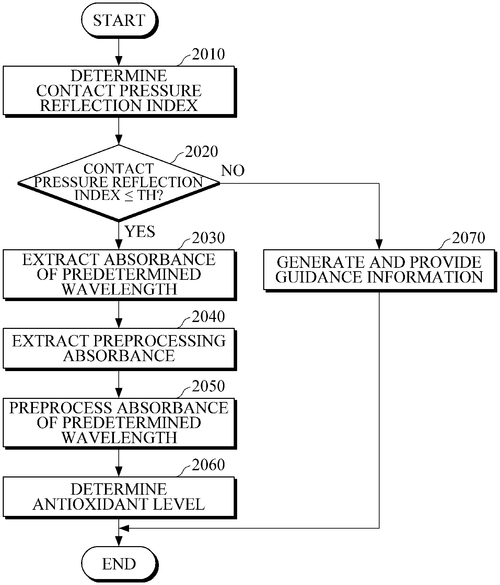
Tech giant Samsung Electronics Co., Ltd. has recently filed a patent for an innovative antioxidant sensor. This sensor includes a touch sensor, a light source, a light receiver, and a processor that work together to analyze the antioxidant levels of an object placed on the sensor. This technology could have wide-ranging applications, from assessing the freshness of food items to monitoring the antioxidant levels in skincare products. The potential uses seem endless, with opportunities for consumers to make healthier choices based on real-time antioxidant data. While this patent showcases Samsung's commitment to pushing the boundaries of innovation, it remains to be seen if this concept will materialize into a consumer product. Competitors in the health and wellness industry may already have similar technologies in development, so Samsung will need to differentiate itself to succeed in this market. The question remains: Will consumers embrace antioxidant sensors as a valuable tool in their daily lives, or is this technology a niche concept that will struggle to find mainstream adoption? Let us know your thoughts in the comments below.
Abstract
An antioxidant sensor according to an aspect of the disclosure includes: a touch sensor; a light source configured to emit light of a predetermined wavelength onto an object touching the touch sensor; a light receiver configured to receive light returning from the object; and a processor configured to extract an image of a contact surface of the object based on a sensor value of the touch sensor, to analyze the extracted image of the contact surface, and to obtain an antioxidant signal of the object by driving the light source based on a result of analyzing the image of the contact surface. An antioxidant sensor according to an aspect of the disclosure includes: a touch sensor; a light source configured to emit light of a predetermined wavelength onto an object touching the touch sensor; a light receiver configured to receive light returning from the object; and a processor configured to extract an image of a contact surface of the object based on a sensor value of the touch sensor, to analyze the extracted image of the contact surface, and to obtain an antioxidant signal of the object by driving the light source based on a result of analyzing the image of the contact surface.
US Patent 12023171
****
What is this invention?
__

Abstract
false
US Patent
SAMSUNG ELECTRONICS CO., LTD.
"Samsung's Innovative Polypeptide Photoresist Revolutionizes Pattern Formation Technology"
What is this invention?
Polypetide, photoresist composition including the same, and method of forming pattern using the same
In the lab, a polypeptide did reign,
In photoresist, it held a grand mainframe,
Forming patterns with such skill and precision,
Striking a chord in the realms of vision,
A marvel of tech, in the research domain.

Samsung Electronics has recently filed a patent for a new invention involving a polypeptide that could revolutionize the world of photoresist compositions. This development has the potential to bring about significant advancements in the field of forming patterns using photoresist, competing with products from established players like Canon and Nikon. Imagine the possibilities this new invention could bring to industries such as semiconductor manufacturing and nanotechnology. With the use of this polypeptide in photoresist compositions, the process of patterning could become more precise and efficient, leading to faster production times and higher quality output. But will this patented technology make its way from concept to consumer products in the near future? How will this innovation impact the current market landscape dominated by other major players? Share your thoughts in the comments below.
Abstract
A polypeptide, a photoresist composition including the polypeptide, a photoresist including the polypeptide, and a method of forming patterns using the photoresist composition. A polypeptide, a photoresist composition including the polypeptide, a photoresist including the polypeptide, and a method of forming patterns using the photoresist composition.
US Patent 12024540
****
What is this invention?
__

Abstract
false
US Patent
SAMSUNG ELECTRONICS CO., LTD.
"Samsung Patents Innovative Recombinant Microorganism for Nitrous Oxide Reduction"
What is this invention?
Recombinant microorganism including genetic modification that increases activity of nitrous oxide reductase pathway and method of reducing concentration of nitrous oxide in sample by using the same
In the lab of biotech creations,
Escherichia gets new variations.
With genes from Pseudomonas,
And Paracoccus bonus,
NosZ reductase sparks innovations.

In a bold move towards sustainability and environmental responsibility, Samsung Electronics Co., Ltd. has filed a patent for a remarkable innovation involving a genetically modified microorganism. This groundbreaking creation, a recombinant microorganism of the Escherichia genus, boasts enhanced expression of a key gene known as NosZ, which codes for a nitrous oxide reductase. This patent signals Samsung's foray into the realm of biotechnology, potentially setting the stage for a new era of eco-friendly solutions from the tech giant. While the specifics of how this microorganism will be utilized remain undisclosed, one can't help but wonder about the potential applications of such a technology. Could we see Samsung leading the charge in creating bio-remediation solutions or perhaps revolutionizing waste treatment processes? With the growing global focus on sustainability and reducing greenhouse gas emissions, this patent certainly piques the curiosity of industry insiders and consumers alike. As we await further developments from Samsung, one can't help but ponder: Will this innovative concept soon become a tangible product in the market, or will it remain a visionary idea confined to the realm of patents? What are your thoughts on the intersection of technology and environmental conservation? Share your insights in the comments below.
Abstract
A recombinant microorganism of the genus Escherichia, comprises a genetic modification that increases expression of a nosZ gene encoding NosZ, which is a nitrous oxide reductase, in the recombinant microorganism, wherein the recombinant microorganism comprises a nosR gene encoding NosR, a nosD gene encoding NosD, a nosF gene encoding NosF, a nosY gene encoding NosY, and an apbE gene encoding ApbE, and wherein the nosR gene, the nosD gene, the nosF gene, the nosY gene and the apbE gene are derived from a microorganism of the genus Pseudomonas, the genus Paracoccus, or a combination thereof. A recombinant microorganism of the genus Escherichia, comprises a genetic modification that increases expression of a nosZ gene encoding NosZ, which is a nitrous oxide reductase, in the recombinant microorganism, wherein the recombinant microorganism comprises a nosR gene encoding NosR, a nosD gene encoding NosD, a nosF gene encoding NosF, a nosY gene encoding NosY, and an apbE gene encoding ApbE, and wherein the nosR gene, the nosD gene, the nosF gene, the nosY gene and the apbE gene are derived from a microorganism of the genus Pseudomonas, the genus Paracoccus, or a combination thereof.
US Patent 12024710
SAMSUNG ELECTRONICS CO., LTD.
"Samsung Patent Revolutionizes Clothing Management with Steam-Powered Apparatus"
What is this invention?
Clothing management apparatus and method for controlling same
A gadget for clothes now in sight,
With memory, steam for clothes just right,
A sensor to feel heat,
And processor neat,
Innovative tech, shining bright!
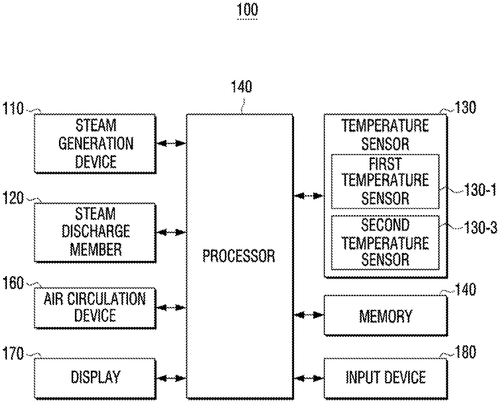
Samsung Electronics Co., Ltd. has recently disclosed a patent for a clothing management apparatus that aims to revolutionize the way we care for our clothes. This innovative device includes a memory, a steam generation apparatus, a steam discharge member, a temperature sensor, and a processor. When a user initiates a clothing management command, the processor stores the temperature inside the apparatus and controls the steam generation accordingly. Notably, if another command is entered shortly after the first, the processor adjusts the steam generation based on the initial temperature data. This new invention from Samsung could potentially streamline the process of caring for our garments, saving time and effort in maintaining their quality. While competitors like LG and Whirlpool offer similar smart home devices, Samsung's clothing management apparatus presents a unique approach to garment maintenance. Imagine a future where you can refresh and remove wrinkles from your clothes with just a simple command to your smart closet. How would this innovative technology fit into your daily routine? Share your thoughts in the comments below.
Abstract
Disclosed is a clothing management apparatus. Disclosed clothing management apparatus comprises: memory; a steam generation apparatus for generating steam; a steam discharge member for spraying clothing with the steam generated by the steam generation apparatus; a temperature sensor for sensing the temperature inside the clothing management apparatus; and a processor which, when a clothing management start command is entered, stores the temperature sensed by the temperature sensor in memory, and controls the steam generation apparatus to carry out the action corresponding to the sensed temperature and clothing management start command, wherein, if an additional clothing management command is entered within a previously set time following an execution of an action corresponding to the clothing management start command, then the processor controls the steam generation apparatus to carry out the action corresponding to the temperature data stored in memory and additional clothing management command. Disclosed is a clothing management apparatus. Disclosed clothing management apparatus comprises: memory; a steam generation apparatus for generating steam; a steam discharge member for spraying clothing with the steam generated by the steam generation apparatus; a temperature sensor for sensing the temperature inside the clothing management apparatus; and a processor which, when a clothing management start command is entered, stores the temperature sensed by the temperature sensor in memory, and controls the steam generation apparatus to carry out the action corresponding to the sensed temperature and clothing management start command, wherein, if an additional clothing management command is entered within a previously set time following an execution of an action corresponding to the clothing management start command, then the processor controls the steam generation apparatus to carry out the action corresponding to the temperature data stored in memory and additional clothing management command.
US Patent 12024812
QUALCOMM Incorporated
"Qualcomm Patent Revolutionizes Wireless Communication with PRS Preemption Indication for UE Positioning"
What is this invention?
Low-layer (DCI or MAC CE) DL puncturing indicator for positioning reference signals (PRS)
In the world of wireless connection,
PRS signals face interception.
Preempted by URLLC's might,
PRS PI signaling the plight,
Identifying domains with perfection.
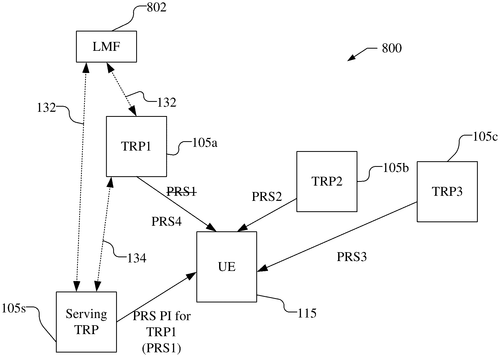
In a recent patent filed by QUALCOMM Incorporated, a new technology has been described that aims to address the issue of downlink positioning reference signals (PRS) being preempted by higher priority transmissions in wireless communication systems. This innovation involves providing a PRS preemption indication (PI) to a user equipment (UE) when PRS transmissions are affected by preemption, identifying the time and frequency domains of the preempted signals. This advancement could potentially revolutionize the way wireless communication systems prioritize transmissions, ensuring that essential positioning reference signals are not disrupted by other traffic. With competitors in the market constantly pushing the boundaries of low-latency communication technologies, this patent by QUALCOMM promises a solution to a critical challenge in the industry. Imagine a future where seamless and reliable positioning services are guaranteed, even in environments with high traffic intensity or varying priorities. Could this technology pave the way for more efficient and accurate location-based services for various applications? What are your thoughts on the significance of prioritizing positioning reference signals in wireless communication systems? How do you envision this innovation impacting the future of location services and connectivity? Share your insights below!
Abstract
During positioning of a user equipment (UE), downlink (DL) positioning reference signals (PRS) transmitted by one or more transmission reception point (TRP) in a wireless communication system may be preempted or punctured by higher priority transmissions, such as ultra-reliable low-latency traffic (URLLC). A PRS preemption indication (PI) may be provided to a UE by a serving TRP identifying one or more TRPs affected by preemption. The PRS PI may further identify the time domain and frequency domain of the preempted DL PRS transmissions. The PRS PI may identify the time domain, e.g., based on a number of PRS symbols between two monitoring occasions, wherein only PRS symbols that contain downlink positioning reference signals associated with the group of TRPs are counted. The PRS PI may identify the frequency domain by identifying at least one of four or more frequency sub-bands of the preempted DL PRS transmissions. During positioning of a user equipment (UE), downlink (DL) positioning reference signals (PRS) transmitted by one or more transmission reception point (TRP) in a wireless communication system may be preempted or punctured by higher priority transmissions, such as ultra-reliable low-latency traffic (URLLC). A PRS preemption indication (PI) may be provided to a UE by a serving TRP identifying one or more TRPs affected by preemption. The PRS PI may further identify the time domain and frequency domain of the preempted DL PRS transmissions. The PRS PI may identify the time domain, e.g., based on a number of PRS symbols between two monitoring occasions, wherein only PRS symbols that contain downlink positioning reference signals associated with the group of TRPs are counted. The PRS PI may identify the frequency domain by identifying at least one of four or more frequency sub-bands of the preempted DL PRS transmissions.
US Patent 12025722
QUALCOMM Incorporated
"Qualcomm's Patent Revolutionizes Flash Memory Interface Configurations"
What is this invention?
Configurable flash memory physical interface in a host device
In a host device, flash memory lies,
Configured by signals, that's wise,
First or second type, make a choice,
Driver circuitry's differential voice,
Receiver circuitry's outputs do rise.
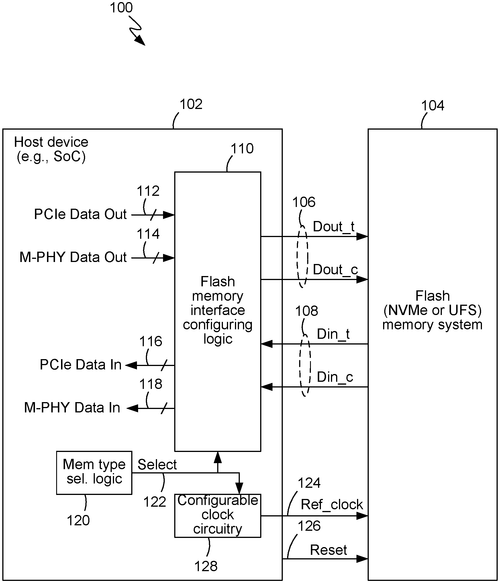
A recent patent application by QUALCOMM Incorporated reveals a new innovation in flash memory physical interfaces for host devices. This technology allows for the configuration of the interface based on the type of flash memory system being used, enhancing efficiency and performance. Competitors in the market, such as Samsung and Intel, currently offer similar products with fixed interfaces, making this adjustable interface a potentially game-changing development. Imagine the possibilities for faster data transfer speeds and improved compatibility with different types of flash memory systems in a variety of devices, from smartphones to laptops. As we eagerly await the implementation of this technology in actual products, one can't help but wonder: Will this new flash memory physical interface set a new standard for device connectivity and pave the way for even more advanced memory systems in the future? Share your thoughts in the comments below.
Abstract
A flash memory physical interface in a host device may be configured based on a selection signal indicating whether a flash memory system is a first type or a second type. Based on the selection signal, either a first differential memory data signal input of driver circuitry or a second differential memory data signal input of the driver circuitry may be coupled to a differential data input of the flash memory system. Based on the selection signal, a differential data output of the flash memory system may be coupled to either a first differential memory data signal output of receiver circuitry or a second differential memory data signal output of the receiver circuitry. A flash memory physical interface in a host device may be configured based on a selection signal indicating whether a flash memory system is a first type or a second type. Based on the selection signal, either a first differential memory data signal input of driver circuitry or a second differential memory data signal input of the driver circuitry may be coupled to a differential data input of the flash memory system. Based on the selection signal, a differential data output of the flash memory system may be coupled to either a first differential memory data signal output of receiver circuitry or a second differential memory data signal output of the receiver circuitry.
US Patent 12026369
QUALCOMM Incorporated
"Qualcomm Patents Groundbreaking Method for Efficient Neural Network Processing"
What is this invention?
Neural network graph partitioning for improved use of hardware resources
In the world of neural networks so vast,
A method for processing is cast.
Nodes are grouped tight,
In a sequence that's right,
In a dance with hardware that's fast.
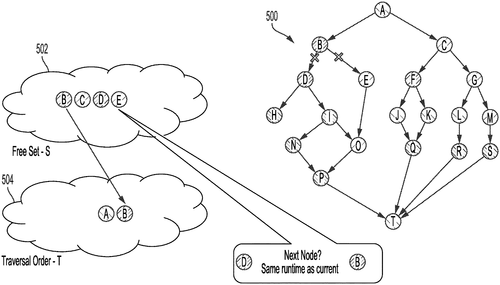
Qualcomm Incorporated has filed a patent for a method aimed at improving the processing of artificial neural networks. This innovative technique involves determining a specific order in which multiple nodes within the network are executed, utilizing a common hardware resource based on various factors such as node frequency and common precedents. Competing products in the market, such as those from NVIDIA and Intel, offer similar neural network processing capabilities, but Qualcomm's method presents a new approach that could potentially enhance efficiency and speed in executing complex neural networks. Imagine a future where this method is implemented in autonomous vehicles, enabling quicker decision-making processes or in healthcare applications for faster medical diagnostics. Will Qualcomm's method revolutionize the way artificial neural networks are processed, or will it face challenges in practical implementation? Share your thoughts in the comments below.
Abstract
A method for processing a neural network includes receiving a graph corresponding to an artificial neural network including multiple nodes connected by edges. The method determines a set of independent nodes of multiple nodes to be executed in a neural network. The method also determines a next node in the set of independent nodes to add to an ordered set of the multiple nodes corresponding to an order of execution via a hardware resource for processing the neural network. The next node is determined based on a common hardware resource with a first preceding node in the ordered set or a frequency of nodes in the set of independent nodes to be executed via a same hardware resource. The ordered set of the plurality of nodes is generated based on the next node. The method may be repeated until each of the nodes of the graph are included in the ordered set of the nodes. A method for processing a neural network includes receiving a graph corresponding to an artificial neural network including multiple nodes connected by edges. The method determines a set of independent nodes of multiple nodes to be executed in a neural network. The method also determines a next node in the set of independent nodes to add to an ordered set of the multiple nodes corresponding to an order of execution via a hardware resource for processing the neural network. The next node is determined based on a common hardware resource with a first preceding node in the ordered set or a frequency of nodes in the set of independent nodes to be executed via a same hardware resource. The ordered set of the plurality of nodes is generated based on the next node. The method may be repeated until each of the nodes of the graph are included in the ordered set of the nodes.
US Patent 12026556
QUALCOMM Incorporated
"Cutting-Edge Point Cloud Encoding Method Patented by QUALCOMM Incorporated"
What is this invention?
Attribute parameter coding for geometry-based point cloud compression
In the land of encoding point cloud,
Attributes in bitstreams are allowed.
Determining parameters with care,
Syntax structures in the air,
Poetry of technology, we are proud.
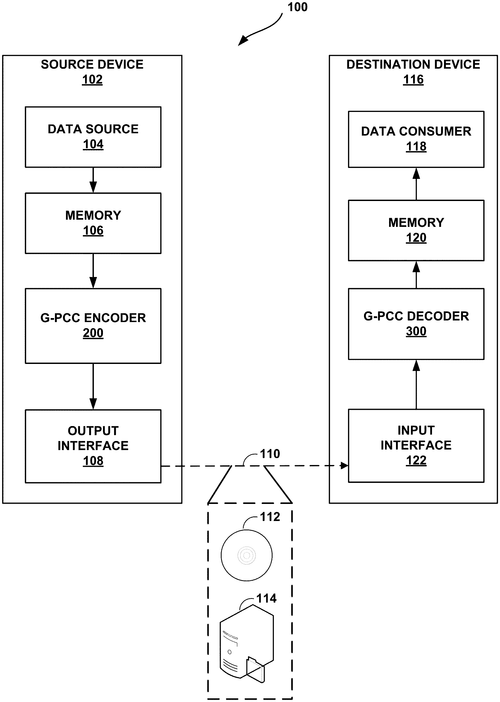
In the fast-paced world of technology, a recent patent application by QUALCOMM Incorporated has caught the attention of industry experts. The patent describes a method of encoding a point cloud, offering a new approach to processing visual data. This innovation could potentially revolutionize the way we interact with augmented reality and virtual reality applications. Competitors in the AR and VR space, such as Oculus and Magic Leap, may need to take note of this development as it could give QUALCOMM an edge in the market. The ability to efficiently encode attribute parameters of a point cloud could lead to smoother graphics and more immersive experiences for users. Imagine a future where virtual worlds are indistinguishable from reality, where detailed point clouds can be rendered in real-time with unparalleled accuracy and clarity. This patent could be the first step towards realizing that vision. But the big question remains: Will QUALCOMM be able to translate this patent into a viable product that consumers can actually use? How soon will we see this technology hit the market, and what impact will it have on the AR and VR landscape? Share your thoughts in the comments below.
Abstract
An example method of encoding a point cloud includes determining one or more attribute parameters of an attribute of a point in the point cloud of a frame, wherein the one or more attribute parameters define how to determine or use a value of the attribute and are applicable to a plurality of points in the point cloud; and signaling, in a bitstream indicative of the point cloud, the one or more attribute parameters in a syntax structure that is specific to the frame. An example method of encoding a point cloud includes determining one or more attribute parameters of an attribute of a point in the point cloud of a frame, wherein the one or more attribute parameters define how to determine or use a value of the attribute and are applicable to a plurality of points in the point cloud; and signaling, in a bitstream indicative of the point cloud, the one or more attribute parameters in a syntax structure that is specific to the frame.
US Patent 12026922
QUALCOMM Incorporated
"Qualcomm's Innovative Patent Revolutionizes Static Occupancy Determination in Three-Dimensional Spaces"
What is this invention?
Static occupancy tracking
In a three-dimensional space so vast,
Techniques for static occupancy are cast.
Map points and pixels align,
Probabilities define,
As images across time overlap and last.
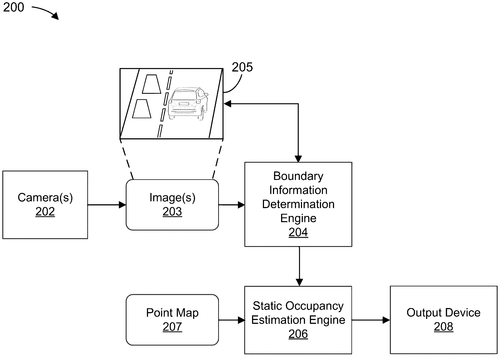
In a recent patent filing by QUALCOMM Incorporated, new techniques and systems have been developed for determining static occupancy in a three-dimensional space. This innovative apparatus is designed to identify and analyze static objects within images, creating a point map that helps calculate the probability of occupancy by these objects in the space. By combining data from multiple images, the system can generate probabilities of occupancy for all cells in a grid associated with the three-dimensional area. Competitors in the tech industry, such as Intel and NVIDIA, have been exploring similar concepts in the realm of spatial awareness and object detection. However, QUALCOMM's approach to static occupancy determination offers a unique and potentially game-changing solution for various applications. Imagine the possibilities of this technology in autonomous vehicles, where accurate detection of static objects in the environment is crucial for safe navigation. Additionally, in smart home systems, precise knowledge of static occupancy in rooms could optimize energy efficiency and enhance security measures. As we look towards the future of technology, how might advancements in static occupancy determination impact industries beyond just automotive and smart home sectors? Share your thoughts below.
Abstract
Techniques and systems are provided for determining static occupancy. For example, an apparatus can be configured to determine one or more pixels associated with one or more static objects depicted in one or more images of a three-dimensional space. The apparatus can be configured to obtain a point map including a plurality of map points, the plurality of map points corresponding to a portion of the three-dimensional space. The apparatus can be configured to determine, based on the point map and the one or more pixels associated with the one or more static objects, a probability of occupancy by the one or more static objects in the portion of the three-dimensional space. The apparatus can be configured to combine information across multiple images of the three-dimensional space, and can determine probabilities of occupancy for all cells in a static occupancy grid that is associated with the three-dimensional space. Techniques and systems are provided for determining static occupancy. For example, an apparatus can be configured to determine one or more pixels associated with one or more static objects depicted in one or more images of a three-dimensional space. The apparatus can be configured to obtain a point map including a plurality of map points, the plurality of map points corresponding to a portion of the three-dimensional space. The apparatus can be configured to determine, based on the point map and the one or more pixels associated with the one or more static objects, a probability of occupancy by the one or more static objects in the portion of the three-dimensional space. The apparatus can be configured to combine information across multiple images of the three-dimensional space, and can determine probabilities of occupancy for all cells in a static occupancy grid that is associated with the three-dimensional space.
US Patent 12026954
TOYOTA JIDOSHA KABUSHIKI KAISHA
"Innovative Vehicle Compressor Installation Structure Patent by Toyota Jidosha Kabushiki Kaisha"
What is this invention?
Compressor installation structure for vehicle
In a vehicle structure so neat,
A compressor installation complete.
Battery low, power unit high,
Electric power lets compressor fly,
Efficient design, technology sweet.

Toyota's latest patent reveals an innovative compressor installation structure for vehicles, featuring a unique configuration that optimizes space and efficiency. Positioned below the floor of the vehicle cabin, the design includes a battery, power unit, and compressor, all strategically placed to enhance performance. This setup not only ensures effective use of space but also maximizes electric power supply for the compressor's operation. In a market saturated with traditional vehicle compressor installations, Toyota's new design offers a fresh take on optimizing vehicle functionality. By streamlining the layout and placement of essential components, this patent opens up possibilities for improved energy efficiency and compact design in future vehicle models. Imagine a world where cars are not only sleek and powerful but also environmentally friendly and space-conscious. Could this innovative compressor installation structure pave the way for a new era of intelligently designed vehicles? How might this technology influence the future of electric vehicles and sustainable transportation systems? Let us know your thoughts in the comments below.
Abstract
A compressor installation structure for a vehicle has: a battery that is disposed at a vehicle lower side of a floor portion of a vehicle cabin; a power unit that is disposed at one side in a vehicle front-rear direction with respect to the battery; and a compressor that is configured to be driven by electric power supplied thereto from the battery, and that is disposed at one side in the vehicle front-rear direction with respect to the battery, and that is disposed at another side in a vehicle front-rear direction with respect to the power unit. A compressor installation structure for a vehicle has: a battery that is disposed at a vehicle lower side of a floor portion of a vehicle cabin; a power unit that is disposed at one side in a vehicle front-rear direction with respect to the battery; and a compressor that is configured to be driven by electric power supplied thereto from the battery, and that is disposed at one side in the vehicle front-rear direction with respect to the battery, and that is disposed at another side in a vehicle front-rear direction with respect to the power unit.
US Patent 12023984
TOYOTA JIDOSHA KABUSHIKI KAISHA
"Revolutionizing Vehicle Safety: Toyota Patents Advanced Display Control Device for Enhanced Object and Lane Visualization"
What is this invention?
Display control device for a vehicle, display method, program, and display system for a vehicle
In a vehicle control device so keen,
Memory and processor work in a sheen,
Object and lane displays they show,
In the cabin where they glow,
Adjusting display ratio pristine.
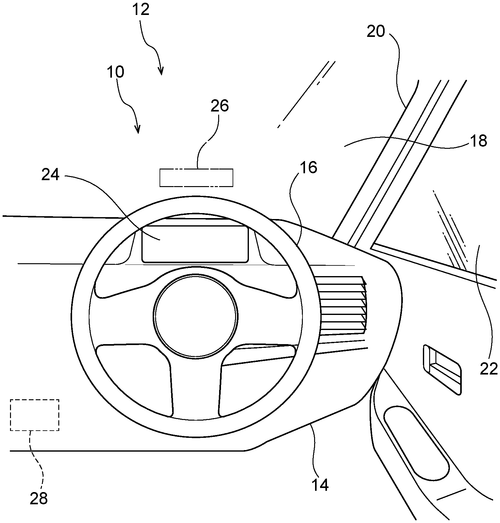
A new patent from Toyota has revealed an innovative display control device for vehicles that could revolutionize the way we navigate roads. This device includes a memory and processor that work together to display an object display and a lane display in the vehicle's cabin. The object display shows an object in front of the vehicle, while the lane display depicts the lane extending in front. What sets this apart is that both displays are shown from the side of the object where the vehicle is positioned. Competitors in the automotive industry, such as Tesla and BMW, have not yet introduced a similar feature in their vehicles. The potential uses for this technology are vast, from enhancing driver awareness to providing a more immersive driving experience. Imagine never missing a pedestrian or obstacle on the road again, thanks to this advanced display control device. The real question is: Will this patent from Toyota make its way into actual production vehicles anytime soon? How do you think this innovation could impact the future of driving? Share your thoughts in the comments below.
Abstract
A display control device for a vehicle includes a memory and a processor connected to the memory. The processor is configured to display an object display and a lane display at a display section provided in a cabin of the vehicle. The object display depicts an object located in front of the vehicle, the lane display depicts a lane extending in front of the vehicle, and the object display and lane display are each displayed as a view thereof from the side of the object at which the vehicle is disposed. The processor is also configured to, in accordance with a distance between the object and the vehicle, alter a display ratio of the object display relative to a width of the lane display. A display control device for a vehicle includes a memory and a processor connected to the memory. The processor is configured to display an object display and a lane display at a display section provided in a cabin of the vehicle. The object display depicts an object located in front of the vehicle, the lane display depicts a lane extending in front of the vehicle, and the object display and lane display are each displayed as a view thereof from the side of the object at which the vehicle is disposed. The processor is also configured to, in accordance with a distance between the object and the vehicle, alter a display ratio of the object display relative to a width of the lane display.
US Patent 12024015
TOYOTA JIDOSHA KABUSHIKI KAISHA
"Wired for Efficiency: Toyota Patent Introduces Smart Solar-Powered Vehicle Technology"
What is this invention?
Vehicle control device, vehicle control method, non-transitory storage medium, and vehicle
In a vehicle with solar to spare,
A control device's job is to pair,
Electric power from sun,
Counts operations done,
Ensuring conditions are fair.
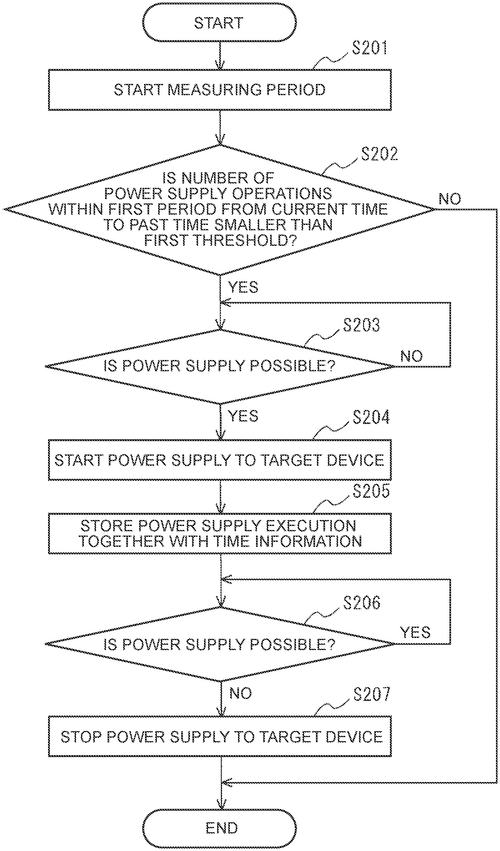
The latest patent from Toyota promises a vehicle equipped with a solar panel and an intelligent control device, designed to efficiently manage the supply of electric power generated by the panel. This innovative technology includes a feature that keeps track of the number of times power is supplied from the solar panel to a target device, allowing the control device to make informed decisions based on specific conditions. While Toyota's patent showcases a forward-thinking approach to sustainability and energy efficiency in vehicles, it raises questions about how this technology will fare against competitors in the market, such as electric vehicles with advanced energy management systems. Imagine the possibilities this solar-powered vehicle could bring, from reducing carbon emissions to providing a more eco-friendly transportation solution. But will consumers be ready to embrace this technology on a larger scale, and will it truly make a significant impact in the push towards a greener future? What are your thoughts on the intersection of renewable energy and transportation? Let us know in the comments below.
Abstract
A vehicle includes a solar panel and a vehicle control device. The vehicle control device is configured to control supply of electric power generated by the solar panel, configured to count the number of power supply operations in which the electric power is supplied from the solar panel to a target device that is a power supply destination, configured to determine whether the number of power supply operations satisfies a first condition, to configured execute power supply from the solar panel to the target device when determination is made that the number of power supply operations satisfies the first condition. The vehicle control device is configured not to execute the power supply from the solar panel to the target device when determination is made that the number of power supply operations does not satisfy the first condition. A vehicle includes a solar panel and a vehicle control device. The vehicle control device is configured to control supply of electric power generated by the solar panel, configured to count the number of power supply operations in which the electric power is supplied from the solar panel to a target device that is a power supply destination, configured to determine whether the number of power supply operations satisfies a first condition, to configured execute power supply from the solar panel to the target device when determination is made that the number of power supply operations satisfies the first condition. The vehicle control device is configured not to execute the power supply from the solar panel to the target device when determination is made that the number of power supply operations does not satisfy the first condition.
US Patent 12024040
TOYOTA JIDOSHA KABUSHIKI KAISHA
"Toyota's Innovative Charge Control System Enhances Efficiency and Performance"
What is this invention?
Charge control system, charge control device, and recording medium
In a system charged with great skill,
A processor performs its strong will.
It calculates charge in a flash,
First amount greater, a bold dash.
Controlled with precision until.
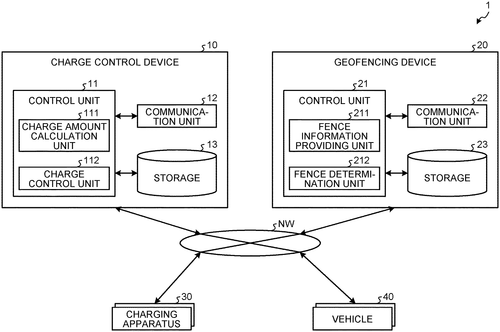
A new patent from Toyota promises an innovative charge control system that could revolutionize the way we power our vehicles. This system includes a charging apparatus and a charge control device with a processor that calculates the amount of charge in a unique way. The patent suggests that the system will prioritize charging in certain time periods to optimize efficiency. Competitors in the electric vehicle market, such as Tesla and Nissan, already offer advanced charging systems, but Toyota's patent hints at a potential game-changer. Imagine a future where your car automatically charges at the most optimal times, saving you money and reducing your environmental impact. However, as with many patents, the real question is whether this technology will make it from the drawing board to our driveways. Will Toyota be able to bring this charge control system to market, and if so, how will it stack up against existing solutions? Share your thoughts in the comments below.
Abstract
A charge control system includes: a charging apparatus; and a charge control device including a processor calculating a charge amount of the charging apparatus and perform charging control. Further, the charge amount is calculated in a manner that a first charge amount is greater than a second charge amount, the first charge amount being the charger amount which is charged in a first time period which is from a predetermined reference time point until the engine driving prohibited zone is set, the second charge amount being the charger amount which is charged in a second time period which is from the predetermined reference time point until the engine driving prohibited zone is set, and the first time period being shorter than the second time period. A charge control system includes: a charging apparatus; and a charge control device including a processor calculating a charge amount of the charging apparatus and perform charging control. Further, the charge amount is calculated in a manner that a first charge amount is greater than a second charge amount, the first charge amount being the charger amount which is charged in a first time period which is from a predetermined reference time point until the engine driving prohibited zone is set, the second charge amount being the charger amount which is charged in a second time period which is from the predetermined reference time point until the engine driving prohibited zone is set, and the first time period being shorter than the second time period.
US Patent 12024044
****
"Revolutionary Agricultural Implement System Patented for Precise Fan Control"
What is this invention?
System and method for controlling fan operation of an agricultural implement
In fields where crops grow and thrive,
A system ensures produce will arrive.
Fans control air with precision,
Conveying crops with no derision,
Technology helping farmers to survive.
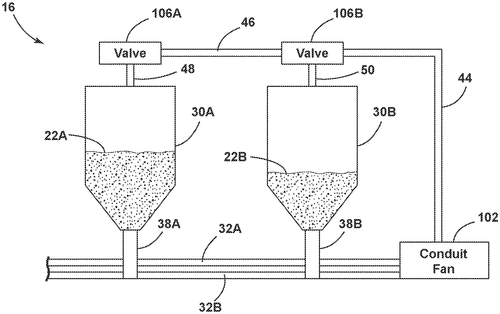
In the world of agricultural technology, a patent has been filed for a system that aims to revolutionize fan operation for agricultural implements. This system includes a tank for storing agricultural products, a conduit for receiving the dispensed products, and fans that supply pressurized air to facilitate the movement of these products through the system. A sophisticated computing system is at the heart of this innovation, monitoring air pressures within the conduit and tank to optimize the flow of pressurized air based on pressure differentials. Competitors in this space, such as traditional agricultural fan systems, may soon have to contend with this potentially game-changing invention. Imagine the possibilities of increased efficiency and precision in distributing agricultural products across fields, leading to higher yields and reduced resource wastage. But will this system truly make its way from patent to production? How might farmers benefit from such a technology in their day-to-day operations? Share your thoughts in the comments below.
Abstract
A system for controlling fan operation of an agricultural implement includes a tank configured to store an agricultural product and a conduit configured to receive the dispensed agricultural product. Furthermore, the implement includes a conduit fan configured to supply pressurized air to the conduit such that the pressurized air conveys the dispensed agricultural product through the conduit and a tank fan configured to supply pressurized air to the tank. Additionally, a computing system is configured to determine a first pressure of the pressurized air within the conduit and a second pressure of the pressurized air within the tank based. Moreover, the computing system is configured to determine a pressure differential between the first and second pressures. Furthermore, the computing system is configured to control a flow of the pressurized air supplied to the tank based on the determined pressure differential. A system for controlling fan operation of an agricultural implement includes a tank configured to store an agricultural product and a conduit configured to receive the dispensed agricultural product. Furthermore, the implement includes a conduit fan configured to supply pressurized air to the conduit such that the pressurized air conveys the dispensed agricultural product through the conduit and a tank fan configured to supply pressurized air to the tank. Additionally, a computing system is configured to determine a first pressure of the pressurized air within the conduit and a second pressure of the pressurized air within the tank based. Moreover, the computing system is configured to determine a pressure differential between the first and second pressures. Furthermore, the computing system is configured to control a flow of the pressurized air supplied to the tank based on the determined pressure differential.
US Patent 12022762
****
"Revolutionizing Agricultural Precision: Patent Introduces Time-Synchronized Controllers for Seamless Actions on Farming Machines"
What is this invention?
Planter control using timestamp/location stamps
In fields where technology reigns supreme,
Controllers on machines in sync they gleam,
Identifying actions with precision keen,
Timestamps and actuators in their dream,
Agricultural tasks done smoothly, a seamless stream.
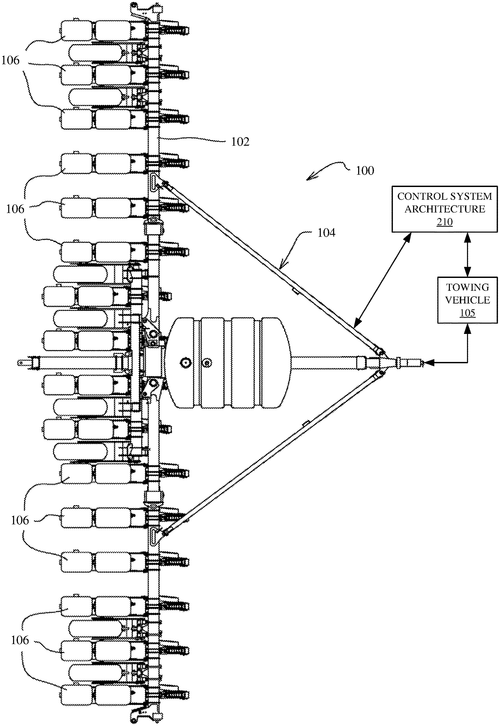
A new patent has been filed for a technology that synchronizes multiple controllers on agricultural machines to improve efficiency in field operations. The system is designed to identify actions based on the location and speed of the machine, as well as the geographic location where the action needs to be taken. This information is then used to generate a timestamp for when the action should occur, which is sent to an actuator controller to control the actuators accordingly. This technology could potentially revolutionize the way agricultural tasks are carried out, ensuring precise and timely actions on the field. While current competitor products offer similar functionalities, the synchronization of controllers in this patent sets it apart from the rest by optimizing the coordination of actions. Imagine the possibilities of a farm where every machine operates seamlessly in sync, maximizing productivity and reducing waste. How might this advancement in agricultural technology impact efficiency and yield in the industry? Share your thoughts in the comments below.
Abstract
A plurality of different controllers on an agricultural machine are time synchronized. A first controller, identifies an action to be taken based upon a location of the agricultural machine and a speed of the agricultural machine, and also based on a geographic location of where the action is to be taken, and generates a timestamp indicating a time at which the action is to be taken. An action identifier and the timestamp are sent to an actuator controller that controls an actuator to take the action. The actuator controller identifies an actuator delay corresponding to the actuator and controls the actuator to take the action at a time identified in the timestamp based upon the actuator delay. A plurality of different controllers on an agricultural machine are time synchronized. A first controller, identifies an action to be taken based upon a location of the agricultural machine and a speed of the agricultural machine, and also based on a geographic location of where the action is to be taken, and generates a timestamp indicating a time at which the action is to be taken. An action identifier and the timestamp are sent to an actuator controller that controls an actuator to take the action. The actuator controller identifies an actuator delay corresponding to the actuator and controls the actuator to take the action at a time identified in the timestamp based upon the actuator delay.
US Patent 12022764
****
"Revolutionary Plant Growing System Maximizes Bud Production and Growth"
What is this invention?
Flowering plant growing system and method of using same
In a plant growing system so grand,
Limbs are held by a bud platform band,
Buds spread out in a planar dance,
Towards a cover, they advance,
Adjustable heights, growth at our command.
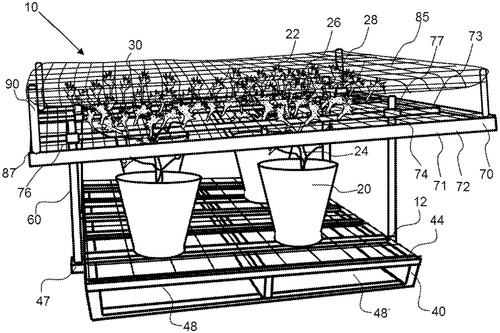
In a recent patent, a new flowering plant growing system has been unveiled that aims to revolutionize the way plants are cultivated. This innovative system allows the limbs of a flowering plant to be supported along a platform, encouraging the growth to spread out horizontally in a planar configuration. The design is intended to stimulate the plant to produce buds that are evenly distributed across the platform and grow upwards towards a cover. Not only that, but the height of the platform and cover can be adjusted, providing flexibility in plant maintenance. Competitor products in the market may include traditional plant pots or hanging planters, which do not offer the same level of support and controlled growth as this new system. The potential uses for this invention are vast, ranging from home gardening to commercial cultivation in greenhouses. The ability to manipulate the growth pattern of plants could lead to higher yields and healthier crops. As we marvel at the possibilities of this new flowering plant growing system, one cannot help but wonder: Will this innovation become the new standard in plant cultivation methods? How might this technology impact the future of agriculture and urban gardening practices? Share your thoughts in the comments below.
Abstract
A flowering plant growing system utilizes a flowering plant growth assembly that enables the limbs of a flowering plant to be retained and supported along a bud platform to spread the growth out in a planar configuration. This type of growth arrangement may stimulate the plant to produce buds that are distributed across the bud platform and may grow up from the bud platform toward a cover. The height of the bud platform and cover may be adjustable as they are secured to vertical supports by retainers. A flowering plant growing system utilizes a flowering plant growth assembly that enables the limbs of a flowering plant to be retained and supported along a bud platform to spread the growth out in a planar configuration. This type of growth arrangement may stimulate the plant to produce buds that are distributed across the bud platform and may grow up from the bud platform toward a cover. The height of the bud platform and cover may be adjustable as they are secured to vertical supports by retainers.
US Patent 12022774
****
Innovative Biodegradable Arbor Stake Stabilization Invention Takes Root
What is this invention?
Arbor stake stabilization member
There once was a stake stabilizer,
Made of materials that were wiser.
With a locking member so tight,
It held trees just right,
Till it biodegraded, nature's adviser.
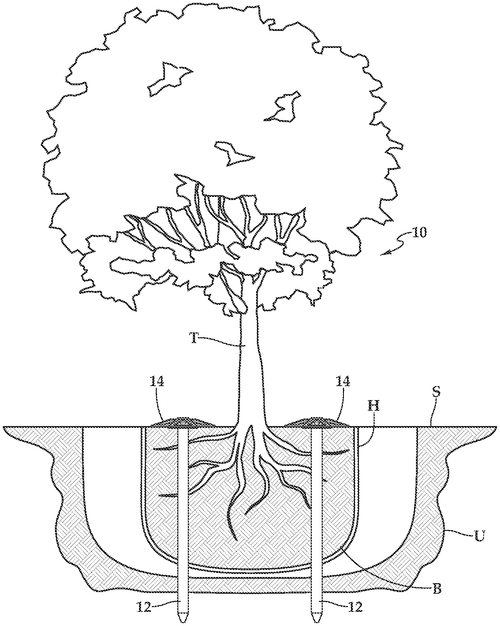
In the world of tree support accessories, a new patent has caught the eye of avid gardeners and environmental enthusiasts alike. The arbor stake stabilization member boasts a design featuring a biodegradable annular ring with an axial passageway, coupled with a locking member and a perforated plate for added stability. This innovative device can be used in conjunction with tree rootballs, providing both support and eco-friendliness as it gradually biodegrades over time. While traditional arbor stakes and supports are commonplace in the market, this new patent offers a sustainable alternative that aligns with the growing environmental consciousness of consumers. Imagine a world where your trees are not only supported but also nurtured by a product that respects nature's cycles. As competitors scramble to keep up with evolving consumer preferences for sustainable products, the arbor stake stabilization member presents a promising solution that combines function and environmental responsibility. But the question remains: Will this patent see the light of day as a consumer product, or will it remain a novel idea in the realm of tree care innovations? Share your thoughts in the comments below.
Abstract
An arbor stake stabilization member comprising a body including an annular ring of a biodegradable material having an axial passageway therethrough. A locking member is coupled to the annular ring and extends radially inward into the axial passageway. A plate of a biodegradable material extends circumferentially outwardly from the annular ring. The perforated plate includes multiple openings. In use, the arbor stake stabilization member may be placed underground and on or above a rootball of a tree. The locking member is sized to accept an arbor stake therethrough in an interference fit. The arbor stake may extend from the top of the rootball through the rootball and into the undisturbed soil at a point below the rootball. Over time, the arbor stake stabilization member biodegrades. An arbor stake stabilization member comprising a body including an annular ring of a biodegradable material having an axial passageway therethrough. A locking member is coupled to the annular ring and extends radially inward into the axial passageway. A plate of a biodegradable material extends circumferentially outwardly from the annular ring. The perforated plate includes multiple openings. In use, the arbor stake stabilization member may be placed underground and on or above a rootball of a tree. The locking member is sized to accept an arbor stake therethrough in an interference fit. The arbor stake may extend from the top of the rootball through the rootball and into the undisturbed soil at a point below the rootball. Over time, the arbor stake stabilization member biodegrades.
US Patent 12022775
****
"Pioneering Root Irrigation Apparatus Patent Revolutionizes Plant Care Technology"
What is this invention?
Root irrigation apparatus
In a garden of tech innovation,
A root irrigation sensation,
With a chamber and valve,
To water plants, we shall solve,
A high-tech agricultural temptation.
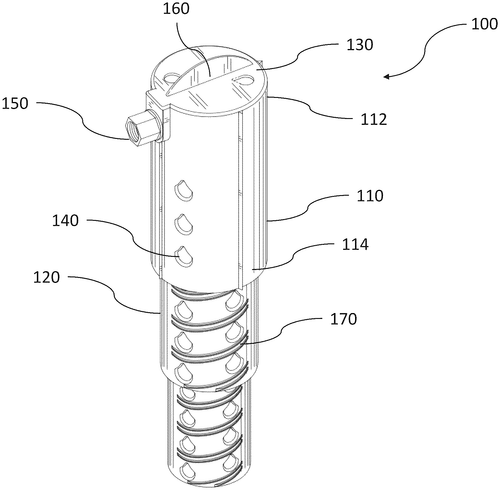
A new patent application has been making waves in the world of agritech, with the promise of revolutionizing the way we water our plants. The root irrigation apparatus described in the patent features a chamber with an irrigation aperture and a cleverly designed valve, all topped off with a cap for easy coupling. While similar products from competitors exist in the market, this patent stands out for its simplicity and efficiency. Imagine the time and water savings this apparatus could bring to farmers and gardeners alike, ensuring that plants receive the precise amount of water they need directly at the roots. But will this innovative invention ever see the light of day? Will it become a practical solution for plant watering on a large scale, or will it remain just another interesting idea in the world of patents? Let us know in the comments below – could this be the game-changer the industry has been waiting for, or will it end up gathering dust on the shelf of unrealized inventions?
Abstract
A root irrigation apparatus includes a chamber including a first end, a second end, and, an irrigation aperture, a valve operably connected to the first end of the chamber, and, a cap configured to couple to the first end of the chamber. A root irrigation apparatus includes a chamber including a first end, a second end, and, an irrigation aperture, a valve operably connected to the first end of the chamber, and, a cap configured to couple to the first end of the chamber.
US Patent 12022778